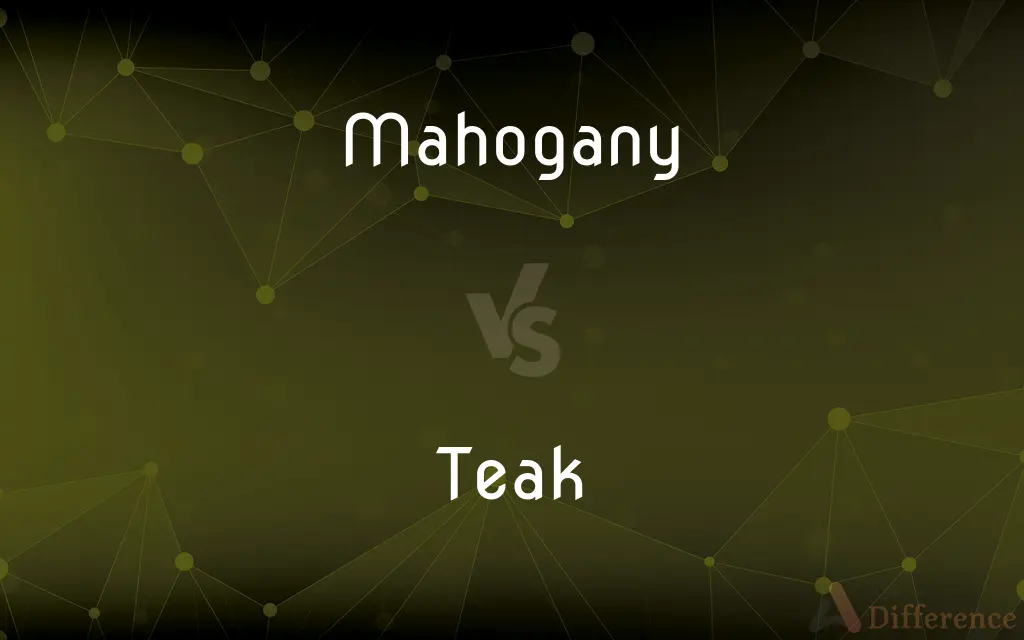Mahogany vs. Teak — What's the Difference?
By Tayyaba Rehman & Maham Liaqat — Updated on April 15, 2024
Mahogany is known for its straight-grained, reddish-brown timber, ideal for fine furniture; while teak is highly valued for its durability and water resistance, often used in outdoor furniture and boat building.

Difference Between Mahogany and Teak
Table of Contents
ADVERTISEMENT
Key Differences
Mahogany wood, originating mainly from tropical regions like South America and Africa, is celebrated for its beauty and workability, making it a favorite for indoor furniture and detailed woodwork. Whereas teak, primarily sourced from Southeast Asia, is exceptionally robust and contains natural oils that repel water, making it perfect for outdoor environments and marine applications.
In terms of color, mahogany exhibits a rich, dark reddish-brown that deepens over time, adding a touch of elegance to any piece. On the other hand, teak showcases a golden to medium brown hue that gradually weathers to a silver-gray finish when exposed to the elements.
Mahogany is relatively soft compared to teak, scoring 800 on the Janka hardness scale, which makes it easier to cut and shape. On the other hand, teak is harder, with a Janka rating of around 1,070, contributing to its excellent durability and resistance to wear and tear.
The cost of mahogany is generally lower than that of teak, which is often priced at a premium due to its superior qualities and the growing scarcity of high-quality stocks. This makes teak a more expensive option, especially for large projects or high-end furniture.
Environmental concerns also differ between the two woods. Mahogany, often harvested from vulnerable forests, has faced issues with deforestation and legality, leading to strict trade regulations. Teak, while also facing sustainability issues, is now more commonly grown in responsibly managed plantations to ensure a stable supply chain.
ADVERTISEMENT
Comparison Chart
Origin
Tropical regions (South America, Africa)
Southeast Asia
Durability
Good, but less durable than teak
Excellent, highly resistant to decay and weathering
Hardness (Janka Scale)
800
1,070
Common Uses
Fine furniture, decorative woodwork
Outdoor furniture, boat building, exterior construction
Color and Weathering
Reddish-brown, darkens over time
Golden-brown, weathers to silver-gray
Compare with Definitions
Mahogany
Prized for its color and durability in indoor settings.
Mahogany flooring adds warmth to the room.
Teak
Weathers to a silver-gray if not treated.
The teak patio set has developed a patina over time.
Mahogany
Can be more affordable compared to other exotic woods.
Choosing mahogany allowed us to stay within budget for the project.
Teak
Features natural oils that protect against decay.
The teak bench remains undamaged despite years outdoors.
Mahogany
Often used in high-quality furniture due to its workability.
Mahogany chairs are both sturdy and elegant.
Teak
Tends to be more expensive due to its desirable properties.
Teak furniture is an investment because of its long lifespan.
Mahogany
Susceptible to changes in appearance with age and light exposure.
Over time, the mahogany cabinet deepened to a darker shade.
Teak
Known for its durability and resistance to water and pests.
Teak is often used for outdoor decking due to its resilience.
Mahogany
Tropical hardwood known for its beauty and fine grain.
The antique desk was crafted from rich mahogany.
Teak
Ideal for marine applications, like boat building.
Teak is a top choice for yacht decks because it withstands harsh conditions.
Mahogany
Mahogany is a straight-grained, reddish-brown timber of three tropical hardwood species of the genus Swietenia, indigenous to the Americas and part of the pantropical chinaberry family, Meliaceae.
Teak
Teak (Tectona grandis) is a tropical hardwood tree species in the family Lamiaceae. It is a large, deciduous tree that occurs in mixed hardwood forests.
Mahogany
Hard reddish-brown timber from a tropical tree, used for quality furniture.
Teak
A large deciduous tree (Tectona grandis) in the mint family, native to tropical South and Southeast Asia, having hard, heavy, durable yellowish-brown wood.
Mahogany
The tropical tree which produces mahogany.
Teak
The wood of this tree, used especially for furniture and in shipbuilding.
Mahogany
Any of several tropical American evergreen trees of the genus Swietenia of the family Meliaceae, especially S. mahagoni and S. macrophylla, valued for their hard, reddish-brown wood.
Teak
A grayish yellowish brown or grayish to moderate brown.
Mahogany
The wood of any of these trees, used in making furniture and musical instruments.
Teak
An extremely durable timber highly valued for shipbuilding and other purposes, yielded by Tectona grandis (and Tectona spp.).
Mahogany
Any of several trees of the family Meliaceae having similar wood, such as African mahogany.
Teak
(countable) A tree of the species in the genus Tectona
Mahogany
Any of several trees of other families having similar wood, such as Philippine mahogany.
Teak
(uncountable) A yellowish brown colour, like that of teak wood.
Mahogany
The wood of any of these trees.
Teak
Of a yellowish brown colour, like that of teak wood.
Mahogany
A moderate reddish brown.
Teak
A tree of East Indies (Tectona grandis) which furnishes an extremely strong and durable timber highly valued for shipbuilding and other purposes; also, the timber of the tree.
Mahogany
(uncountable) The wood of any of various tropical American evergreen trees, of the genus Swietenia, mostly used to make furniture.
Teak
Hard strong durable yellowish-brown wood of teak trees; resistant to insects and to warping; used for furniture and in shipbuilding
Mahogany
(countable) Any of the trees from which such wood comes.
Teak
Tall East Indian timber tree now planted in western Africa and tropical America for its hard durable wood
Mahogany
(regional) A Cornish drink made from gin and treacle.
Mahogany
A reddish-brown color, like that of mahogany wood.
Mahogany
A table made from mahogany wood; a dining table.
Mahogany
Made of mahogany.
Mahogany
Having the colour of mahogany; dark reddish-brown.
Mahogany
A large tree of the genus Swietenia (Swietenia Mahogoni), found in tropical America.
Mahogany
The wood of the Swietenia Mahogoni. It is of a reddish brown color, beautifully veined, very hard, and susceptible of a fine polish. It is used in the manufacture of furniture.
Mahogany
A table made of mahogany wood.
Mahogany
Wood of any of various mahogany trees; much used for cabinetwork and furniture
Mahogany
Any of various tropical timber trees of the family Meliaceae especially the genus Swietinia valued for their hard yellowish- to reddish-brown wood that is readily worked and takes a high polish
Common Curiosities
Why is teak preferred for outdoor furniture?
Teak’s natural oils and high resistance to decay make it ideal for outdoor furniture and marine environments.
How does the color of mahogany change over time?
Mahogany deepens to a darker reddish-brown as it ages, which enhances its visual appeal.
What makes teak resistant to water and pests?
Teak contains natural oils that repel water, fungi, and insects, making it durable in various conditions.
Can mahogany be used outdoors like teak?
While mahogany can be used outdoors, it does not offer the same level of durability or resistance as teak.
Is mahogany environmentally sustainable?
Due to concerns over deforestation, mahogany is now more strictly regulated to ensure sustainable sourcing.
Why is teak more expensive than mahogany?
Teak’s superior qualities and the scarcity of high-quality sources contribute to its higher cost.
Where is mahogany typically sourced from?
Mahogany is typically harvested from the tropical regions of South America and Africa.
What is the primary use of mahogany?
Mahogany is primarily used for indoor furniture and detailed woodwork due to its workability and aesthetic appeal.
What are the environmental impacts of teak cultivation?
Teak cultivation in plantations aims to reduce the strain on natural forests, though it still requires careful management to ensure sustainability.
How does teak weather when exposed to the elements?
If left untreated, teak gradually turns from a golden-brown to a silver-gray.
What are the hardness ratings of mahogany and teak?
Mahogany has a Janka hardness of 800, making it softer than teak, which has a rating of 1,070.
Where is teak wood commonly found?
Teak is primarily found in Southeast Asia and is also cultivated in plantations in tropical regions.
Are there any special care requirements for mahogany furniture?
Mahogany furniture should be regularly polished and kept away from direct sunlight to maintain its color and finish.
How does the cost of mahogany and teak compare for large projects?
Teak generally costs more than mahogany, making it a pricier option for large-scale or luxury projects.
What are some common finishes used on teak to maintain its color?
Teak is often treated with oils or sealants to preserve its natural color and protect against weathering.
Share Your Discovery

Previous Comparison
Grass vs. Sedge
Next Comparison
Advise vs. CounselAuthor Spotlight
Written by
Tayyaba RehmanTayyaba Rehman is a distinguished writer, currently serving as a primary contributor to askdifference.com. As a researcher in semantics and etymology, Tayyaba's passion for the complexity of languages and their distinctions has found a perfect home on the platform. Tayyaba delves into the intricacies of language, distinguishing between commonly confused words and phrases, thereby providing clarity for readers worldwide.
Co-written by
Maham Liaqat















































